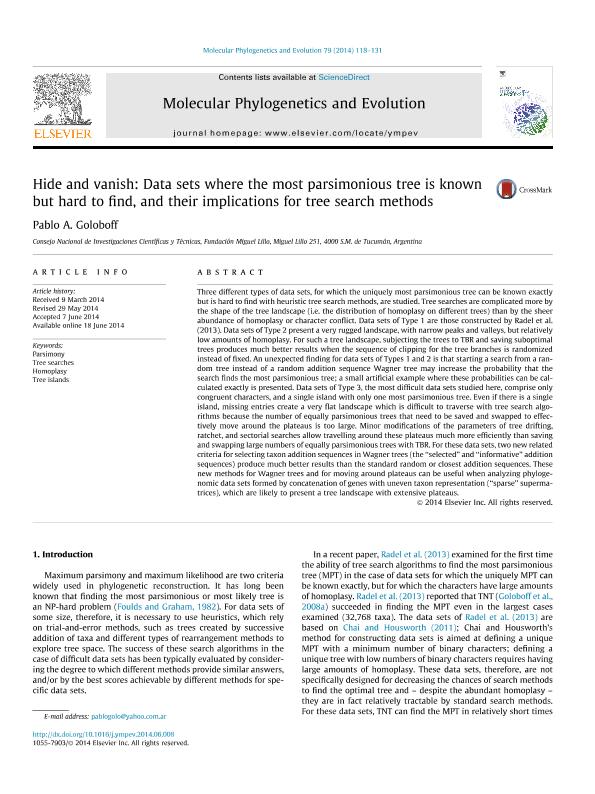Mostrar el registro sencillo del ítem
dc.contributor.author
Goloboff, Pablo Augusto

dc.date.available
2016-08-22T14:35:38Z
dc.date.issued
2014-06
dc.identifier.citation
Goloboff, Pablo Augusto; Hide and vanish: data sets where the most parsimonious tree is known but hard to find, and their implications for tree search methods; Elsevier; Molecular Phylogenetics And Evolution; 79; 6-2014; 118-131
dc.identifier.issn
1055-7903
dc.identifier.uri
http://hdl.handle.net/11336/7262
dc.description.abstract
Three different types of data sets, for which the uniquely most parsimonious tree can be known exactly but is hard to find with heuristic tree search methods, are studied. Tree searches are complicated more by the shape of the tree landscape (i.e. the distribution of homoplasy on different trees) than by the sheer abundance of homoplasy or character conflict. Data sets of Type 1 are those constructed by Radel et al. (2013). Data sets of Type 2 present a very rugged landscape, with narrow peaks and valleys, but relatively low amounts of homoplasy. For such a tree landscape, subjecting the trees to TBR and saving suboptimal trees produces much better results when the sequence of clipping for the tree branches is randomized instead of fixed. An unexpected finding for data sets of Types 1 and 2 is that starting a search from a random tree instead of a random addition sequence Wagner tree may increase the probability that the search finds the most parsimonious tree; a small artificial example where these probabilities can be calculated exactly is presented. Data sets of Type 3, the most difficult data sets studied here, comprise only congruent characters, and a single island with only one most parsimonious tree. Even if there is a single island, missing entries create a very flat landscape which is difficult to traverse with tree search algorithms because the number of equally parsimonious trees that need to be saved and swapped to effectively move around the plateaus is too large. Minor modifications of the parameters of tree drifting, ratchet, and sectorial searches allow travelling around these plateaus much more efficiently than saving and swapping large numbers of equally parsimonious trees with TBR. For these data sets, two new related criteria for selecting taxon addition sequences in Wagner trees (the “selected” and “informative” addition sequences) produce much better results than the standard random or closest addition sequences. These new methods for Wagner trees and for moving around plateaus can be useful when analyzing phylogenomic data sets formed by concatenation of genes with uneven taxon representation (“sparse” supermatrices), which are likely to present a tree landscape with extensive plateaus.
dc.format
application/pdf
dc.language.iso
eng
dc.publisher
Elsevier

dc.rights
info:eu-repo/semantics/openAccess
dc.rights.uri
https://creativecommons.org/licenses/by-nc-nd/2.5/ar/
dc.subject
Phylogeny
dc.subject
Tree Searches
dc.subject
Parsimony
dc.subject.classification
Biología

dc.subject.classification
Ciencias Biológicas

dc.subject.classification
CIENCIAS NATURALES Y EXACTAS

dc.title
Hide and vanish: data sets where the most parsimonious tree is known but hard to find, and their implications for tree search methods
dc.type
info:eu-repo/semantics/article
dc.type
info:ar-repo/semantics/artículo
dc.type
info:eu-repo/semantics/publishedVersion
dc.date.updated
2016-08-17T15:40:16Z
dc.journal.volume
79
dc.journal.pagination
118-131
dc.journal.pais
Países Bajos

dc.journal.ciudad
Amsterdam
dc.description.fil
Fil: Goloboff, Pablo Augusto. Fundación Miguel Lillo; Argentina. Consejo Nacional de Investigaciones Científicas y Técnicas. Centro Científico Tecnológico Tucumán; Argentina
dc.journal.title
Molecular Phylogenetics And Evolution

dc.relation.alternativeid
info:eu-repo/semantics/altIdentifier/url/http://www.sciencedirect.com/science/article/pii/S1055790314002218
dc.relation.alternativeid
info:eu-repo/semantics/altIdentifier/doi/http://dx.doi.org/10.1016/j.ympev.2014.06.008
dc.relation.alternativeid
info:eu-repo/semantics/altIdentifier/doi/10.1016/j.ympev.2014.06.008
Archivos asociados
